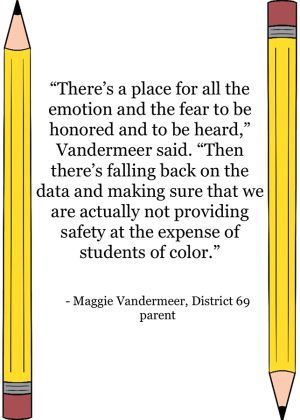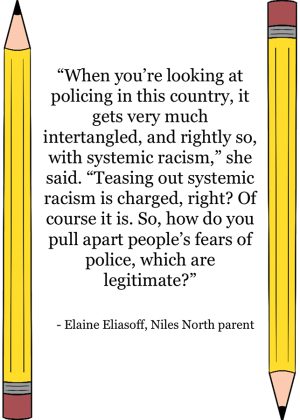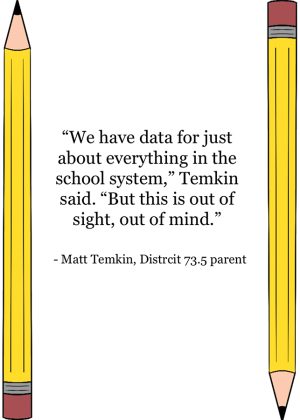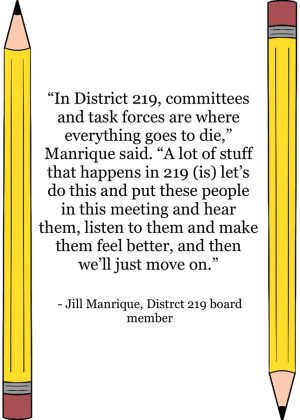In Focus: As community members remain split on SROs in Niles Township high schools, the district fails to act
February 11, 2022
Content warning: This story contains mentions of police violence and gun violence.
When Jasmine Sebaggala’s 15-year-old daughter went to get a drink during her lunch period at Niles West High School in November 2021, she was stopped by two school security officers.
Before studying with a teacher during her break, Sebaggala’s daughter tried to enter the cafeteria. To get in, she had to show identification, Sebaggala said. She had used a photo of her ID before with no issue, but this time, the officers threatened to report her to the dean for not showing a physical form of identification.
During the interaction, Sebaggala said her daughter was respectful to the officers and asserted that she didn’t do anything wrong. But the officers asked her why she was there, questioning whether she was assigned to that lunch period.
After about 30 minutes, a Niles West dean arrived and resolved the situation, allowing Sebaggala’s daughter to get a drink. But Sebaggala said the interaction demonstrated how the district continues to ignore the well-being of Black children in its schools by policing students.
According to the National Center for Education Statistics, nearly half of American public schools had some form of armed law enforcement personnel in 2018. Advocates say these personnel, including school resource officers, help keep students safe, but critics say their presence could instead expose students to police brutality and worsen the school-to-prison pipeline.

The SRO debate made its way to District 219 in summer 2020 when school board members heard more than 50 public comments on the topic of school resource officers at the board’s June 9 meeting. This public outcry continued throughout the summer and led district leaders to establish a task force to evaluate safety and security.
However, conversations with District 219 parents, teachers and board members revealed the task force did little to resolve the harm school resource officers inflict on students of color.
Sebaggala, who is a Black mother, said allowing a school resource officer in the building is a sign that the district “doesn’t care about (her) Black daughter.”
“They’re continuing to not consider the plight and the feelings of our Black children, how unsafe they feel, how they already have to deal with not seeing teachers that look like them,” Sebaggala said.
A community split on SROs
The purpose of the SRO at Niles North High School is to serve as a law-related enforcer, counselor and presenter. Niles West outlines its officer’s duties to also include roles such as community liaison and educator.
But Nicole Reynolds (Niles North ’98), a physical education and health teacher at Niles West, said during most of her time at the school, many of its SROs have rarely interacted with students.
Reynolds recalled never seeing these SROs in the halls, only patrolling the cafeteria.
“I never saw him have a relationship with the kids. And I’ll be honest with you, if there’s a gun on the third floor and he’s in the cafeteria, what good is he going to do?” Reynolds said. “It’s a waste.”
Niles North parent Elline Eliasoff said she thinks school resource officers can help keep students safe. Eliasoff, whose children have been in the district for more than 10 years, said this type of presence is reassuring in light of recent school shootings across the country.
“Does one police officer in the school ensure that our kids are always going to be safe? No,” Eliasoff said. “But does one police officer in the school help get the emergency rescue services there? Can they have disaster plans in place? Can they lock down the school when necessary? Do things happen quicker when there’s a police on premises? 100%, yes.”
During her time as a parent in District 219, Eliasoff said there have been two bomb threats leading to school evacuations. In those circumstances, she said the school resource officer put the evacuation plan into place.
Matthew Cuellar, who researches school safety and climate at the University of Alaska Anchorage, said school resource officers can be a determining factor in the culture of a school. When these officers develop relationships with students, it can create a safe space, he said.
“(Relationship building) helps us address some of the stigma around policing, particularly in these lower-income or higher-need communities,” Cuellar said. “It’s really important that we develop and foster the positive relationship between (students) and police.”
However, these personal relationships are difficult to form when school resource officers have the power to arrest students at any moment, according to Luca Guacci, a researcher and managing attorney for the education advocacy program at the James B. Moran Center for Youth Advocacy.
“It’s not a bad idea for police officers to build relationships with the community,” Guacci said. “But it doesn’t need to happen inside of a school building.”

Maggie Vandermeer, a parent in District 69, which feeds into District 219, said it’s understandable that people are scared for students’ safety. She said these concerns have become more prevalent in the wake of recent threats at nearby Evanston Township High School/District 202 and at her own child’s school, Lincoln Junior High School.
In December 2021, ETHS SROs and safety staff recovered two handguns after detaining students for smoking cannabis in a school bathroom. The school was under lockdown for three hours. During the same month, Lincoln Junior High was the target of a threat on social media. District 69 coordinated with the Skokie Police Department to assess the threat, which was ultimately determined to be a hoax.
But Vandermeer said District 219 cannot make decisions about the SROs’ presence out of fear.
While many people claim SROs help in these situations, Vandermeer said there’s no hard evidence that they are the ones keeping students safe — and they could be harming marginalized students.
In the 2015-16 school year, the national arrest rate of Black students was three times that of white students, according to the American Civil Liberties Union. Latinx students were 1.3 times more likely to be arrested at school than their white counterparts.

“There’s a place for all the emotion and the fear to be honored and to be heard,” Vandermeer said. “Then there’s falling back on the data and making sure that we are actually not providing safety at the expense of students of color.”
Assembling a task force
In September 2020, District 219 Superintendent Steven Isoye asked Niles West teacher D.J. Kosiba and Niles North teacher Angie Hankes to facilitate a task force evaluating the schools’ SRO program in response to public outcry. The group’s end goal was to present recommendations about the presence of school resource officers in the district.
Though he agreed to put the group together, Kosiba said he questioned its ability to create change because many of the district’s recent equity work had come to little fruition and felt like performative or empty actions.
“(It’s a lot of asking) a bunch of people who are passionate about issues to put in their time and effort, often with no pay,” Kosiba said. “Then say that we did it and move on without actually changing anything.”
Kosiba said he and Hankes moved forward with “very little to no guidance” from the superintendent. Although Isoye initiated the task force, Kosiba said the superintendent hasn’t communicated with him throughout the process. Isoye declined The Daily’s request for comment.
From the beginning, Kosiba said the group wanted to make its work not only about SROs, but also about general safety and security in the district. Broadening the task force’s purpose allowed the team to consider actions such as insourcing the district’s security staff.
Matt Temkin, a parent in District 73.5, also served on the task force, but he and a retired Skokie police officer both left the group before it completed its recommendations. Temkin said members’ personal feelings around the issue made the meetings difficult, and he didn’t believe he was adding value to the group.
Members of the group openly insulted and criticized one another for their opinions, Eliasoff said. She described the task force as a disaster. The meetings weren’t anything close to a safe space, and with inconsistent attendance, the information wasn’t shared equally among the members, she added.
The task force’s final recommendations were not universally agreed upon when they were presented in May 2021, Eliasoff said. The committee also consistently failed to present unbiased evidence, she wrote in a dissension letter.

“When you’re looking at policing in this country, it gets very much intertangled, and rightly so, with systemic racism,” she said. “Teasing out systemic racism is charged, right? Of course it is. So, how do you pull apart people’s fears of police, which are legitimate?”
Redefining student resources
As the task force met, nearby districts reckoned with their own relationships to local police departments and considered what new models of discipline could look like.
Vandermeer is also an organizer of Skokie Schools Equity Collaborative, a group seeking to eradicate harm and marginalization across Skokie school districts. She said these discussions aren’t unique to Niles high schools.
“We have an opportunity to make things better,” Vandermeer said. “Especially in (District 219), Black students are a minority, and it’s incredibly important to keep that as a focus.”
During their meetings, the task force looked to local districts as examples, finding a model of a successful relationship with SROs in District 207’s Maine East High School in Park Ridge.
Omar Salem, who previously worked as a teacher at Niles North, said Maine East has a more comprehensive intergovernmental agreement with Maine Township than the one District 219 has with the Village of Skokie. An IGA is a legally enforceable contract between governmental entities. Community members on all sides of the SRO argument liked Maine East’s IGA as a model for District 219, he said.
A December 2021 Moran Center report also considered alternative models of school safety for ETHS. The report found a large part of the SROs’ responsibility is to informally counsel students, but Guacci said the officers are not adequately trained for this role.
The Moran Center recommends following the National Association of Social Workers’ suggestion of having one social worker in a school for every 250 students, Guacci said. Increasing mental health resources and restorative justice would further efforts to invest in real prevention strategies centered around student well-being, they said.
The report suggests ETHS should follow a whole-school restorative justice model, which focuses on student support rather than punitive discipline. Implementing this kind of model could include elevating the work of leadership teams of students, faculty, staff and parents, which would allow all stakeholders to have a voice in deciding discipline methods.
While there’s no one vision for a restorative justice model in schools, Guacci said such a culture would support all stakeholders to respond to problems without exclusionary discipline to support healing.
“It’s practices and ideals and visions, and not just one vision,” they said. “But it’s more about an approach to make sure that people feel safe.”
Task force takeaways
The task force members presented their findings to the Board of Education in May 2021. While they did not come to a unanimous decision or recommendation, they asked the district to consider a number of possibilities for the future of its SRO program.
The group recommended four possible avenues to improve student well-being in a wide range of scenarios, including keeping the SRO inside the building or removing the position entirely.
The task force also asked the district to hire safety staff as full-time employees rather than outsourced staff members, as well as add a director of safety to standardize protocols across campuses.
The group’s last recommendation was to emphasize restorative practices over punitive discipline, including by involving students in decision-making around security.
However, the task force faced complications because school resource officers at Niles high schools haven’t disaggregated all incident data by race and gender. The group urged the district to track specific demographic data for students experiencing discipline and police contact.
Temkin said the district is doing a disservice to its students and parents by not having more data on the SROs.

“We have data for just about everything in the school system,” Temkin said. “But this is out of sight, out of mind.”
A lack of action
Once the task force presented its findings, the community waited.
The board was set to vote on whether to end the intergovernmental agreement with Skokie police in July. But with a vacancy at the time, board member Jill Manrique told The Daily some on the board felt the vote wouldn’t have “a good outcome.”
These members pushed to remove the vote from the agenda and delay a decision until the vacancy was filled, which resulted in an automatic renewal of the contract, Manrique said.
The district’s IGA requires a year of warning if the board plans to end the agreement. As a result, advocates would have to wait longer for SROs to be removed, even if they garnered board support. However, other districts have been able to negotiate to end their IGAs earlier.
“That’s the part that really bothers me, because all of the work that was done, all of the outpouring, shared experiences … it’s traumatic to have to share a traumatic experience again,” Vandermeer said. “The work of the administration and really thoughtful recommendations, all of that just seems to be dropped.”
Vandermeer said community members are left with no clear answers as to why action hasn’t been taken. To her, it seems as if the district doesn’t care about making changes, even as students continue to be confronted by police officers.
With two new board members and another who is consistently absent, Manrique said bringing the issue up again is a risk because they may not have enough information to vote.
Temkin said there’s been a lot of excuses made by district leaders since the task force presented its findings.
“It’s really disappointing that the task force spent over a year looking into research, talking to experts, talking to students (and) parents, and had recommendations, and it’s still an ongoing issue,” Temkin said.
An unclear future
Eliasoff, the Niles North parent, said she’ll never get back the time she dedicated to the task force. She spent six months on it, and at the end of the day, she said it didn’t matter.
“The task force was nothing short of a nightmare, and my biggest regret was that I sat through the end of it,” Eliasoff said. “I am not someone who walks away from commitments, but I would have been better to have walked out on that than to have sat through those hellacious, interminable, never-ending meetings.”

Manrique said she initially pushed for the task force to be created. But now she doesn’t believe it was the right decision.
“In District 219, committees and task forces are where everything goes to die,” Manrique said. “A lot of stuff that happens in 219 (is) let’s do this and put these people in this meeting and hear them, listen to them and make them feel better, and then we’ll just move on.”
At the end of the school year, the district’s superintendent is departing. With two new board members and a new superintendent, Kosiba said community members cannot lose sight of the issue at hand when leadership turns over.
People wouldn’t be so afraid of the SRO debate if they understood it was about human beings, Manrique said. While some people believe those advocating for the removal of SROs are being critical of administrators and police, Manrique sees these actions as acts of care for students.
Manrique said she wants to see real leadership from the district.
“Black parents, Black students, Black teachers, Black administrators and Latinx community members just have to sit there and wait for something to happen,” Manrique said. “(They are) told, ‘We’re working on it, everything’s going to be okay or this takes time. Progress takes time. These things take time.’ Well, f–k that. We don’t have that kind of time.”
Email: oliviaalexander2024@u.northwestern.edu
Twitter: @oliviagalex
Related Stories:
— In Focus: A mom wanted to know whether police pointed guns toward her kids. EPD kept the footage locked away.
— As D219 data shows disproportionate discipline of Black students, security task force member says they are “set up to fail”
— Skokie Schools Equity Collaborative, Abolition Coalition host anti-racist celebration and protest of SROs in D219

